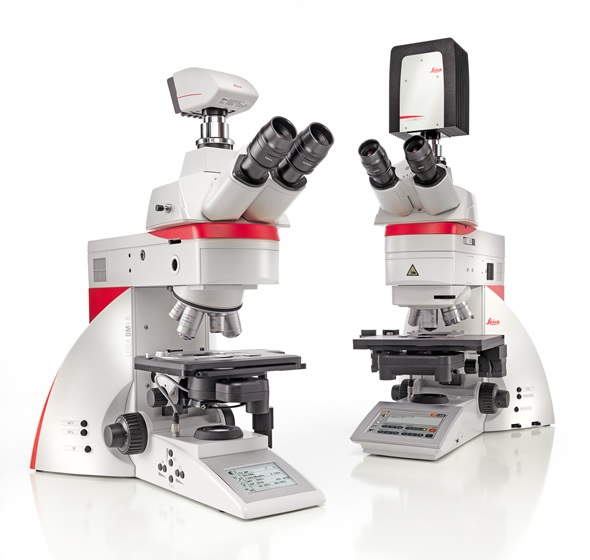Leica Microsystems launches the upright microscopes Leica DM4 B and Leica DM6 B for life science research and clinical applications.
The two systems succeed the Leica DM4000 B, Leica DM5000 B, Leica DM5500 B, and Leica DM6000 B, and build on this previous generation of automated research microscopes. Users can choose between halogen and LED illumination in the transmitted light path, with LED providing constant color temperature for homogeneously lit samples. The camera field of view of 19 mm is matched to the chip size of sCMOS cameras, which have become increasingly popular in life science applications due to their high frame rates and good signal-to-noise ratios. The imaging software Leica Application Suite X (LAS X) guides users through image acquisition step by step and enables easy and fast orientation in the sample.

"Time is precious," says Product Manager Dr. Falk Schlaudraff. "Whether in a life science lab or in a clinic, people want high-quality results in a short time. The Leica DM series of upright microscopes is well-known for intelligent, workflow-oriented application, brilliant optics, and automated capabilities such as enabling users to switch between contrasting methods with just a click of a button. Our new DM upright microscopes meet today's demands by translating the latest trends into technology and offering even simpler operation. That means even inexperienced users can easily take beautiful microscopic images quickly."
The Leica DM4 B and Leica DM6 B microscopes are available with halogen or LED illumination for transmitted light. LEDs are energy-efficient and have a lifetime of up to 25,000 hours, which reduces microscope downtime due to bulb changes. Additionally, LEDs come with a constant color temperature and illuminate specimens homogenously, which is beneficial to imaging and analysis alike.
Due to the 19 mm field of view of the camera imaging port, users can combine the Leica DM4 B and Leica DM6 B with state-of-the-art cameras such as sCMOS and fully exploit their potential. Images are captured efficiently and quickly. "These highly sensitive, high-speed, large-format cameras allow researchers and clinicians to capture greater detail than ever before. With the new camera ports, users invest in imaging today as well as tomorrow - we see an increasing need for speed, sensitivity, and high signal-to-noise ratio which both new instruments can answer," explains Dr. Schlaudraff.
Both instruments are available with the LAS X software which guides users through image acquisition step by step, saving time and providing a quick overview of the specimens. From a complete or dedicated slide overview, users can quickly navigate to a region of interest and zoom in to see details in a higher magnification with the Specimen Overview. "This software functionality helps to further streamline the users' workflow and allows them to identify and image their samples faster. In addition, this feature reduces the training time for non-microscopy experts," comments Dr. Schlaudraff.
The preceding models of the Leica DM4 B and Leica DM6 B were among the first intelligently automated microscopes for researchers and clinicians. Dr. Schlaudraff: "Our customers like these models for their ease of use and flexible system configurations. Examples are the programmable function control buttons and touch panel operation. We consciously kept these functionalities when designing the new instruments for the demands of researchers and clinicians today and tomorrow."
More information: http://www.leica-microsystems.com/products/light-microscopes/life-science-research/upright-microscopes/details/product/leica-dm6-b/. For questions and answers to the two systems please refer to: http://www.leica-microsystems.com/products/light-microscopes/life-science-research/upright-microscopes/details/product/leica-dm6-b/faq/
About Leica Microsystems
Leica Microsystems develops and manufactures microscopes and scientific instruments for the analysis of microstructures and nanostructures. Ever since the company started as a family business in the nineteenth century, its instruments have been widely recognized for their optical precision and innovative technology. It is one of the market leaders in compound and stereo microscopy, digital microscopy, confocal laser scanning microscopy with related imaging systems, electron microscopy sample preparation, and surgical microscopes.
Leica Microsystems has seven major plants and product development sites around the world. The company is represented in over 100 countries, has sales and service organizations in 20 countries, and an international network of distribution partners. Its headquarters are located in Wetzlar, Germany.